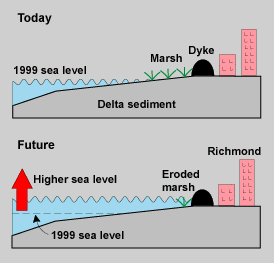| ||||||||||||||||||||||||||||
Proactive disclosure Print version |  Temperature rising: Climate change in southwestern British Columbia Rising seas Most glaciers will shrink as climate warms, and the water from the melting glaciers will raise sea level. Ocean waters will expand as they warm, causing the sea to rise further. The expected rise in sea level over the next 100 years is 15 cm to 95 cm. The effect will be greater in areas such as the Fraser River delta, where the land is slowly sinking due to forces operating deep within the Earth. Sea level could rise much more if parts of the large ice sheets in Antarctica and Greenland were to melt. Vulnerable shorelines As sea level rises, shores formed of loose, easily eroded sediments may shift inland. Even today, parts of the coastline of the Strait of Georgia are eroded by waves during winter storms. Higher seas may also flood deltas, tidal marshes, and other low-lying coastal areas. Dykes may have to be built or upgraded to protect these areas.
The sea cliff at Point Grey near Vancouver is formed of loose, erodible sands and silts. It retreated at rates of up to 60 cm per year before 1982, when coarse gravel was placed at the shore to protect the base of the cliff from wave erosion.
Fraser Delta tidal marshes are critical habitats for waterfowl, shorebirds, and salmon fry. A rise in sea level may drown the marshes or squeeze them against sea dykes that protect Richmond, Ladner, and Delta. 'Coastal Squeeze'  If sea level is going to be higher in the future, should we restrict development along our shorelines? Climate change will affect the habitat, food supply, and migration patterns of birds. Some bird species will increase, and others will decline. What impact would the loss of Fraser Delta marshes have on ducks, geese, and shorebirds that migrate along the Pacific Flyway? References Clague, J.J. and Bornhold, B.D., 1980: Morphology and littoral processes of the Pacific coast of Canada; in The Coastline of Canada, Littoral Processes and Shore Morphology; Geological Survey of Canada, Paper 80-10, p. 339-380.
|